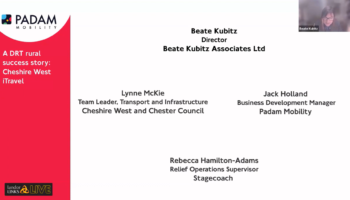In 2019, the Cerema (French Centre for Studies and Expertise on Risks, Environment, Mobility and Urban Planning) created the MaaS Observatory, which lists all the MaaS or intermodal systems initiatives on French territory on a single platform. The aim of this platform is to share knowledge about MaaS.
To explore further the issues of Mobility-as-a-Service, we wanted to share views with an expert on MaaS in France. Laurent Chevereau has been Director of “MaaS ” research project at Cerema for nearly three years.
What is Cerema’s approach to MaaS?
Laurent Chevereau: As with many issues, Cerema has a vocation to provide knowledge. This is why we produce a lot of intelligence and good practices and why we launched the MaaS observatory, in partnership with national partners who bring together all the MaaS players. The idea is to facilitate sharing without necessarily comparing in order to avoid everyone reinventing their own model. Knowledge about MaaS must be a common resource.
For us, as for many local authorities, MaaS must be used to meet specific public policy objectives. In concrete terms, it is not necessarily easy to implement. At Cerema, we are trying to push the need for evaluation: some research has been done on the evaluation of the impacts of MaaS and there is not much, even at international level. In Europe, we see that the impacts are not necessarily positive. The example of MaaS Whim in Helsinki is quite eloquent because it develops the use of public transport but, on the other hand, the modal share of walking and cycling is reduced in favour of car hire.
What kind of advice do you provide for the deployment of MaaS solutions in rural or peri-urban areas?
L.C: To set up a MaaS project, you first have to prioritise the objectives that the territory wishes to address. This is very important, as well as the choice of the target audience, because I don’t think you can make a MaaS for everyone that meets all the objectives.
To sum up, the idea is to define one or two objectives, a main target and then the product: type, ergonomics, pricing policy and support.
In less densely populated areas, there is more of a need for exchange and acculturation to this type of tool, because very often, local authorities do not have as many skills in-house. The financial means are also lacking.
MaaS can have the power to bring together and connect different territories, including the most fragile. For this to happen, digital services must be developed to provide quality intermodal information. However, what are the other major challenges facing MaaS?
L.C: I think there is a major marketing challenge behind this. In large cities, everyone knows the name of the network, but in sparsely populated areas, people do not necessarily know who is in charge of transport and do not necessarily know the name of the network. It is not enough to develop an efficient digital service, it is also necessary to make it known and used, which is not easy in rural areas where digital use is less widespread. On regional intermodal system, we also see that usage is quite low compared to the cost of implementation.
Our publication supports a vision of a sustainable MaaS that should be closer to the territories in order to position itself as a catalyst for mobility offers, including for the most vulnerable populations. How can the development of intermodal logics benefit the territories? Is MaaS the right tool for this?
L.C: I think that we should first of all dissociate regular users from occasional users. In rural areas, alternative solutions to cars (DRT, carpooling, etc.) are going to be difficult to generalise in the short term for everyday journeys. In Saint-Etienne, the interface of the Moovizy application differs depending on whether the user is a regular or irregular user. The proposal of intermodal solutions can be a plus for these areas, but it is above all the multimodal aspect that is important for these areas. These tools can help to identify the right mode at the right time.
The reduction of greenhouse gas emissions is one of the main objectives of MaaS. Between noise and pollution, the car is often blamed, especially in city centres. Does the use of the car have a place in a MaaS system?
L.C: At Cerema, we defend the fact that each form of mobility has its rightful place in space and time. To put it simply, in the city, the car has its place especially at night, where there are no more relevant offers or for specific needs of accompaniment / voluminous shopping.
In sparsely populated areas, the car does not have the same negative externalities as in the city. In terms of climate, the impact is roughly the same, but in terms of inconvenience and congestion it is not comparable.
Thus, reducing car use must be an objective, but not necessarily the primary one in all types of territory. In less well-served areas, the primary objective is to enable everyone to have a mobility solution. This may involve solutions that may generate more emissions, but which are largely compensated by modal shifts in dense areas.
MaaS brings together a wide range of actors and raises the question of governance. Taking into consideration the social and environmental role of MaaS, what would be its ideal form of governance? Who are the most appropriate actors to develop, control and integrate?
L.C: In general, even if private players offer solutions for a certain population, local authorities remain the most legitimate to develop a MaaS. In London, the PTA (Public Transport Administration) was recently obliged to propose a solution for PRMs itself.
Nevertheless, local authorities are looking for the best way to involve private actors, and several are thinking about new types of public-private partnerships.
Is the question of financing the most important issue for MaaS today?
I think so. Today, private players have not yet found a solid economic model, particularly because there is no standardisation yet, nor easy access to sales services.
For public MaaS, local authorities do indeed have financing difficulties. Nevertheless, some MaaS are beginning to emerge because technological solutions are beginning to be available at lower cost.
In other countries, there is more national funding to help deploy MaaS and federate the players.
Intermodality obviously raises the question of the integration of ticketing systems and I believe that this is something that you have studied in detail. Where do we stand today and what are the technical obstacles to the integration of the different operators’ ticketing systems?
Large urban and regional networks often have heavy card-based ticketing. This does not facilitate interoperability with other mobility solutions. However, in recent years, light ticketing based on a back-office has been increasingly developed, in which the support only has an identifier (QR code, M-ticket). On a regional scale, or in large cities, most MaaS will try to mix the two in order not to exclude large transport networks but still take advantage of the benefits of light ticketing, facilitating the integration of digital-based mobility services. In smaller cities, it is easier to base everything on light ticketing.
As part of the MaaS observatory, we have looked into the issue of carpooling and several solutions exist. In Nantes, for example, Klaxit uses the local transport network’s ticketing card: by entering the subscriber’s number on the application, an advantageous rate is offered.
The Dynamic DRT offer is often described as a MaaS enabler. What does the term MaaS enabler mean to you and what do you see as the role of on-demand transport in the MaaS product portfolio?
MaaS has a real vocation to integrate dynamic DRT in its product portfolio, there is a strong interest. However, I am a little surprised that the local authorities are not more involved. This is probably linked to the fact that the dynamic DRT tool is fairly recent
Cerema is a public institution dedicated to supporting public policies, under the dual supervision of the. French Ministry of Ecological Transition and the Ministry of Territorial Cohesion and Relations with Local Authorities.
Cerema shares best practices and contributes to the implementation of accessible mobility policies and services adapted to the social and economic specificities of territories.
These articles might interest you:





